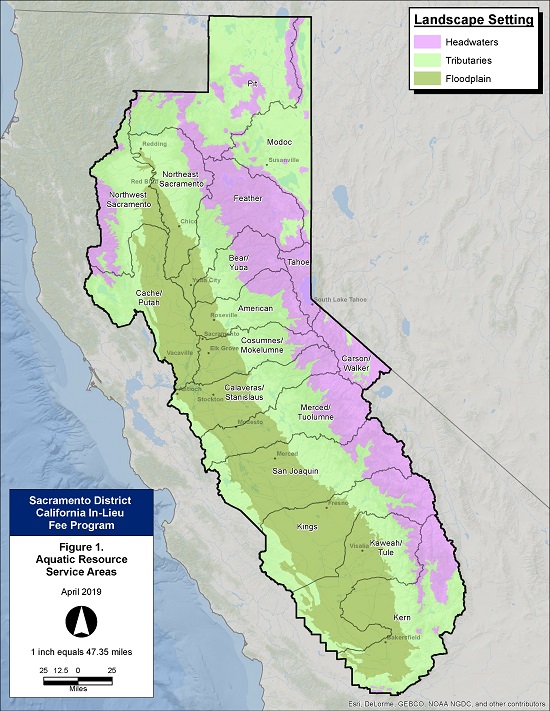Notice of Funding Availability: Sacramento District California In-Lieu Fee Program
Updated October 2023
The National Fish and Wildlife Foundation’s (“NFWF”) Sacramento District California In-Lieu Fee Program (“ILF Program”) was established in October 2014 and approved by the U.S. Army Corps of Engineers (“USACE”), the U.S. Environmental Protection Agency, the National Marine Fisheries Service, the California State Water Resources Control Board, the Central Valley Regional Water Quality Control Board, and the Lahontan Regional Water Quality Control Board (each an “Agency” and collectively the “Agencies”) in accordance with the 2008 Compensatory Mitigation for Losses of Aquatic Resources Final Rule (33 CFR Parts 325 and 332; and 40 CFR Part 230) (the “2008 Rule”).
The ILF Program offers permittees an in-lieu fee option to satisfy their compensatory mitigation obligations as determined by any of the Agencies, as applicable, for impacts to aquatic resources authorized under the Clean Water Act, the Rivers and Harbors Act, the Endangered Species Act, the Porter-Cologne Water Quality Control Act, and other applicable laws, in the “Program Area,” which covers the geographic area under the jurisdiction of the Sacramento District of the USACE within California. For reference, the overall Program Area is subdivided under the ILF Program into discrete geographies comprising 17 “Aquatic Resource Service Areas” and 12 “Vernal Pool Service Areas.” The ILF Program offers two types of Credits: 1) Vernal Pool Credits for authorized impacts to vernal pool wetlands; and 2) Aquatic Resource Credits for authorized impacts to wetlands (excluding vernal pools), other Waters of the United States, Waters of the State, and certain species.
As a result of Aquatic Resource Credit sales to date, NFWF has accumulated certain funds that may be made available to fund projects that establish, enhance, restore, or, in certain circumstances, preserve aquatic resources in an applicable Service Area (“ILF Projects”). NFWF is issuing this Notice of Funding Availability in order to solicit proposals for the implementation of eligible ILF Projects to be funded through the ILF Program.
The ILF Program currently has approximately $11.3 million in available funding for ILF Projects. The funding is divided among seven priority Service Areas as summarized in Table 1.
Table 1. Priority Service Areas and Available Funding.
| Aquatic Resource Service Area | Maximum Potential Funding |
| American River | $562,662 |
| Bear/Yuba Rivers | $2,205,000 |
| Calaveras/Stanislaus Rivers | $1,656,500 |
| Carson/Walker Rivers | $2,505,000 |
| Feather River | $2,171,600 |
| Kaweah/Tule Rivers | $1,171,161 |
| Tahoe | $1,026,434 |
Eligibility Criteria
Eligible ILF Projects must be located in a designated priority Service Area (see map on page 3 of this Notice) and must provide demonstrable benefits to aquatic resources. ILF Projects may be stand-alone projects or may be an identifiable component of a larger restoration project.
In each case, the ILF Project must meet all applicable requirements set forth in the 2008 Rule (see pages 6 and 7 of this Notice).
Eligible applicants include non-profit organizations, U.S. Federal government agencies, state government agencies, local government agencies, Indian tribal entities, educational institutions, and private businesses.
For more information, please contact:
Wetland Program Director, Impact-Directed Environmental Accounts (IDEA)
National Fish and Wildlife Foundation
Direct: (415) 593-7627
Christopher.Gurney@nfwf.org
